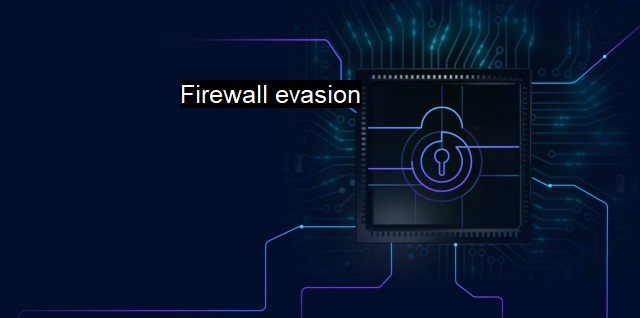What is Firewall evasion?
Exploring Firewall Evasion Techniques: Mitigation Strategies for Cybersecurity Practitioners and Antivirus Vendors
Firewall evasion is a common term which refers to tactics and techniques that cybercriminals use to bypass or evade detection by firewall systems. Firewalls are critical components of network security infrastructure that monitor and control ingoing and outgoing network traffic based on predetermined security rules. Their purpose is to establish a barrier between an internal, secured network and the external, insecure network, mainly the Internet. even with their security measures in place, skilled hackers have discovered several ways to evade these systems.Firewall evasion is primarily about finding a blind spot in the firewall, a vulnerability to allow attackers to slip past undetected. Attackers employ several sophisticated techniques to break through the protective barrier set by firewalls and antivirus programs, which if not monitored properly, can result in security breaches.
One such technique is known as IP fragmentation. This method involves splitting a malicious payload into multiple small packets to evade firewall scanning. When these data packets reach their destination, they reassemble into the harmful payload and compromise the system. Artfully controlling and managing this fragmentation process increases the chances of evading detection, all the more reinforcing the importance of competent and up-to-date firewall systems.
Another technique often used in firewall evasion is the use of encryption and tunneling. Encryption manipulates the data's appearance, so it seems insignificant or normal. once inside the network, this encrypted data reveals its harmful content. Tunneling, which implies guiding data through open ports, is another way to make malicious data seem harmless. As encryption and tunneling mainly manipulate data, traditional firewalls that merely monitor the origin and destination of data traffic are rendered powerless against such attacks.
Obfuscation and polymorphic blending attacks also aid firewall evasion. Hackers purposefully change or obfuscate the signature of malicious codes to prevent detection by firewall systems that rely on database reference. Polymorphic blending attacks are particularly deceitful because intruders create unique, legitimate-looking packet sequences, making the malicious code undetected by behavioral or signature-based antivirus software.
Firewall evasion is a significant concern, further fuelled by the continuous evolution of sophisticated evasion techniques. Cybercriminals constantly devise new methods to bypass firewalls, challenging the security industry to continually innovate and adapt to mitigate potential threats.
The non-stop battle between cybersecurity professionals and hackers emphasizes the need for advanced and adaptive technologies in managing network security. Intrusion Prevention Systems (IPS), AI-based tools, and dedicated anti-evasion solutions are seen as the substantial measures to outsmart firewall evasion measures.
In the ongoing struggle to prevent firewall evasion, organizations need to prioritize a multilayered proactive approach to cybersecurity instead of relying solely on regular firewalls and antivirus software. Continual monitoring and updating of software patches and firewall rules, regular system audits, and employee education regarding phishing attacks effectively reinforce the firewall's primary purpose of securing network systems.
An adaptive cybersecurity strategy needs to be agile and responsive enough to spot and neutralize threats and anomalies. Advanced algorithms capable of detecting suspicious network patterns and implementing predictive threat modeling could respond instantly to threats, enabling quicker setup of countermeasures.
While firewalls and antivirus programs remain central to any cybersecurity strategy, firewall evasion stands as a potent tool in the cybercriminal arsenal. It's important to recognize and understand the nature and implications of firewall evasion, focus on advanced methodologies, vigilance, and thorough understanding of latest tactics employed by hackers. Cybersecurity is an evolving battleground, and the capability to adapt to new threats is the key to keeping systems secure.

Firewall evasion FAQs
What is firewall evasion and why is it a concern in cybersecurity?
Firewall evasion is the practice of bypassing or circumventing firewall security measures that are meant to prevent unauthorized access to a network or system. It's a significant concern in cybersecurity because it can allow attackers to gain access to sensitive data or systems without being detected.What are some common techniques used for firewall evasion?
Some common techniques used for firewall evasion include tunneling, port scanning, remote code execution, and exploiting software vulnerabilities. Attackers may also use social engineering tactics to trick users into bypassing security measures or to gain access to sensitive information.How can organizations protect themselves against firewall evasion attacks?
To protect against firewall evasion attacks, organizations can employ a combination of technical solutions and best practices. This includes implementing firewalls with advanced threat prevention capabilities, keeping security software up-to-date, educating employees about the risks of social engineering attacks, and regularly assessing the effectiveness of security measures.Can antivirus software help prevent firewall evasion attacks?
Antivirus software can help prevent firewall evasion attacks to some extent by detecting and blocking known malware and other malicious code. However, more sophisticated attacks that use new or unknown techniques may be able to evade antivirus detection. As such, organizations should use multiple layers of security, including firewalls, intrusion detection and prevention systems, and other advanced threat prevention technologies, in addition to antivirus software.| | A | | | B | | | C | | | D | | | E | | | F | | | G | | | H | | | I | | | J | | | K | | | L | | | M | |
| | N | | | O | | | P | | | Q | | | R | | | S | | | T | | | U | | | V | | | W | | | X | | | Y | | | Z | |
| | 1 | | | 2 | | | 3 | | | 4 | | | 7 | | | 8 | | |||||||